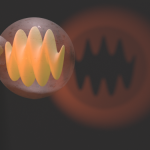 Colloidal quantum dots are incredibly tiny pieces of semiconductor that are mere nanometers wide. Because of the unique ways in which they absorb, emit, and interact with light, colloidal quantum dots have emerged as a unique material platform for next-generation consumer electronic devices such as quantum dot displays and solar cells. Despite decades of research however, there is still much that we do not understand about the way electrons behave in these materials. In particular, the way in which vibrations of the quantum dot, called phonons, affect the electronic dynamics remains poorly understood – mainly because conventional optical techniques such as absorption and fluorescence spectroscopies reveal only broad peaks that obscure any signatures of electron-phonon interactions. To study the underlying physics of these interactions we apply a novel technique called 2-D spectroscopy, which unfolds the broad absorption and fluorescence lineshapes of colloidal quantum dots. By using 2-D spectroscopy to correlate the wavelengths of light that are absorbed and emitted by the quantum dots using pulses of light, we are able to observe how electron-phonon interactions modify subtle fluctuations of the electronic energy gap, which determines the color of light a quantum dot absorbs and emits, on the femtosecond timescale (millionths of a billionth of a second). This insight represents a major step towards rationally designing quantum dots to mitigate the detrimental effects of electron-phonon interactions in practical devices.
Colloidal quantum dots are incredibly tiny pieces of semiconductor that are mere nanometers wide. Because of the unique ways in which they absorb, emit, and interact with light, colloidal quantum dots have emerged as a unique material platform for next-generation consumer electronic devices such as quantum dot displays and solar cells. Despite decades of research however, there is still much that we do not understand about the way electrons behave in these materials. In particular, the way in which vibrations of the quantum dot, called phonons, affect the electronic dynamics remains poorly understood – mainly because conventional optical techniques such as absorption and fluorescence spectroscopies reveal only broad peaks that obscure any signatures of electron-phonon interactions. To study the underlying physics of these interactions we apply a novel technique called 2-D spectroscopy, which unfolds the broad absorption and fluorescence lineshapes of colloidal quantum dots. By using 2-D spectroscopy to correlate the wavelengths of light that are absorbed and emitted by the quantum dots using pulses of light, we are able to observe how electron-phonon interactions modify subtle fluctuations of the electronic energy gap, which determines the color of light a quantum dot absorbs and emits, on the femtosecond timescale (millionths of a billionth of a second). This insight represents a major step towards rationally designing quantum dots to mitigate the detrimental effects of electron-phonon interactions in practical devices.
Publication:
A. Liu, D. B. Almeida, W. K. Bae, L. A. Padilha, and S. T. Cundiff, “Vibrational Coupling Modifies Spectral Diffusion in Core-Shell Colloidal Quantum Dots,” Phys. Rev. Lett. 123, 057403 (2019).
DOI


